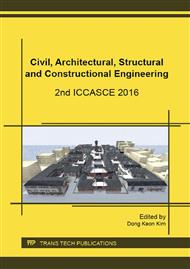p.262
p.267
p.273
p.278
p.282
p.287
p.294
p.300
p.305
Low-Noise Asphalt Pavements in Urban Areas
Abstract:
Current requirements for the reduction of the noise pollution in inhabited areas are constantly increasing. Acoustic wearing courses represent the real measures how to directly mitigate sources of road traffic noise created by a tire/road contact. Directly reduced noise emissions created by a tire/road contact don't need further mitigation by expensive noise barriers. Noise emissions on two different types of wearing courses of asphalt mixtures (Asphalt concrete for very thin layers and Low-noise stone mastic asphalt) were measured using the specialized device operating on the basis of CPX (Close Proximity method) and compared with the standard mixture of Asphalt concrete. Differences were between 1 dB and 5 dB depending on the wearing course and the vehicle speed. The efficiency of the low-noise asphalt pavements was also compared with the initial costs of the pavements. The economical evaluation confirmed that the initial costs of the acoustic wearing courses are higher than the costs of the standard asphalt concrete mixture. However the noise reduction by 1 dB using the asphalt concrete for very thin layers increases the costs just by 350 USD (considering the same length and width of the road segment), which makes acoustic wearing courses the economically efficient noise reducing measure.
Info:
Periodical:
Pages:
282-286
Citation:
Online since:
November 2016
Authors:
Keywords:
Price:
Сopyright:
© 2017 Trans Tech Publications Ltd. All Rights Reserved
Share:
Citation:


